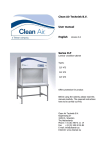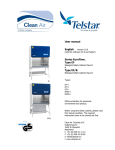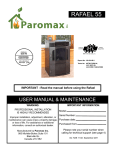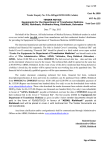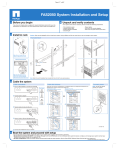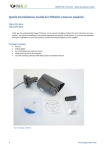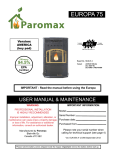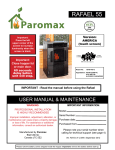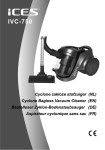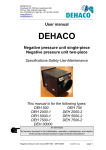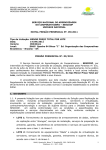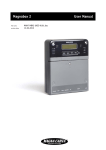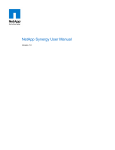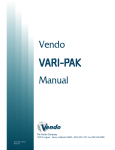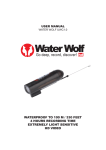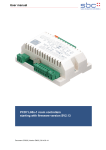Download Clean Air Techniek B.V. User manual English
Transcript
Clean Air Techniek B.V. User manual English Version 02 (valid for software V1.0 and higher) Series MSC III Biological Safety Cabinet Class III Types: MSC III 1200 MSC III 1500 MSC III 1800 Offers protection for personnel, environment and product. Before using the safety cabinet, please read this manual carefully. The required instructions have to be carried out first. Clean Air Techniek B.V. Kuipersweg 37 3449 JA Woerden The Netherlands Phone: +31 (0) 348 41 11 14 Fax: +31 (0) 348 42 26 84 E-mail: [email protected] Internet: www.cleanairbv.com MSC III Biological Safety Cabinet Clean Air Techniek B.V. Preface Congratulations with your new Biological Safety Cabinet from Clean Air Techniek B.V. This is the user manual of the MSC III Biological Safety Cabinet Class III. The cabinet meets all the latest requirements and the European standard that is necessary for Microbiological Safety Cabinets, the EN 12469:2000. While developing the MSC III cabinet, we took the wishes and demands of our users into account. The primary function is safety for personnel, product and environment, but also ergonomics, design and ease of use are supplementary criteria. To comply with all these wishes and demands the MSC III has been designed and built. The MSC III is the most progressive safety cabinet currently available. The EN 12469:2000 describes only the minimum requirements, which creates a base for the high demands Clean Air Techniek B.V. pursuits for its products. The MSC III is a high-quality product constructed with high-grade components and materials, with new techniques, such as: ̇ Microprocessor control with a LCD display for the interface with the user; ̇ Automatic up speeding fan (only with option booster fan) when there is increasing resistance in the filter the necessary airspeeds are maintained; ̇ User-friendly window construction with a hinge mechanism easy to operate. Furthermore the MSC III is a service friendly installation, produced in the Netherlands. We thank you for buying this cabinet and wish you good times working with our MSC III Biological Safety Cabinet Class III. Clean Air Techniek B.V. Version table Ver. 02 Version: 22-07-08 Date: From serial number: AK/MP By: Check: Update for microprocessor controls Change: ©Copyright 2008 All rights reserved. Nothing from this edition may be copied, or used in an automated database, or made public, either electronic, mechanical, by photocopies, recordings, or in any manner, without preceding written permission of Clean Air Techniek B.V. This also counts for the accompanying figures and/or plans. Clean Air Techniek B.V. is entitled to change parts on each desired moment, without preceding or direct notification of the customer. The content of this user manual can be changed without preceding warning as well. For information concerning maintenance activities or repairs which are not mentioned in the user manual, please contact the service organization. This user manual has been put together with all possible care, but Clean Air Techniek B.V. cannot take the responsibility for possible mistakes in this user manual or for the consequences of it. UM-MSCIII-EN02.doc 2 MSC III Biological Safety Cabinet Clean Air Techniek B.V. TOC 1 Introduction _______________________________________________ 6 2 Safety ____________________________________________________ 7 2.1 2.2 2.3 2.4 2.5 3 Installation (& Transport) ____________________________________ 10 3.1 3.2 3.3 3.4 4 Type plate ___________________________________________________________15 Body of the installation _________________________________________________15 Electrical connections __________________________________________________15 Hinged window with clamps _____________________________________________16 Operating panel _______________________________________________________16 Top hood with pressure gauge __________________________________________16 Socket outlet(s) (optional) ______________________________________________17 Transfer hatch (position 8, 9, 10) _________________________________________17 Gloves and leak test cap (position 11, 12 and 27) ____________________________17 FL lights (position 14) __________________________________________________17 Electronics ___________________________________________________________17 Filter systems_________________________________________________________18 Disinfection facilities (optional) ___________________________________________18 External booster fan (optional) ___________________________________________18 Support frame (optional)________________________________________________18 Back side ____________________________________________________________18 Fan _________________________________________________________________19 Optional Fittings ______________________________________________________19 Control___________________________________________________ 21 5.1 5.2 6 Transport regulations __________________________________________________10 Setting up the installation _______________________________________________10 Assembly-instruction ___________________________________________________10 Dismantling & Disposal _________________________________________________12 Product description _________________________________________ 13 4.1 4.2 4.3 4.4 4.5 4.6 4.7 4.8 4.9 4.10 4.11 4.12 4.13 4.14 4.15 4.16 4.17 4.18 5 Use in conformity with regulations _________________________________________7 Modifications and changes to the installation _________________________________7 Authorized persons _____________________________________________________7 General safety aspects __________________________________________________8 Explanation user safety symbols ___________________________________________9 Using the cabinet______________________________________________________21 Cabinets positions _____________________________________________________21 Starting up the cabinet ______________________________________ 22 6.1 6.2 6.3 6.4 Start the cabinet ______________________________________________________23 Locking functions cabinet _______________________________________________24 Power save mode ( Not available for MSC III-series)__________________________25 Turn off _____________________________________________________________25 UM-MSCIII-EN02.doc 3 MSC III Biological Safety Cabinet 6.5 6.6 6.7 6.8 6.9 6.10 7 Cleaning the installation ________________________________________________45 Cleaning the UV-light (optional) __________________________________________46 Small maintenance and service ________________________________ 47 9.1 9.2 9.3 9.4 9.5 9.6 10 Flow alarm ___________________________________________________________43 Pressure alarm________________________________________________________43 Other alarms _________________________________________________________43 Cleaning__________________________________________________ 45 8.1 8.2 9 Control UV (optional)___________________________________________________25 Control Gas supply (Not available on the MSC III cabinets) ____________________26 Control sockets _______________________________________________________26 Menu functions _______________________________________________________27 Information status cabinet ______________________________________________35 Settings _____________________________________________________________38 Alarms ___________________________________________________ 42 7.1 7.2 7.3 8 Clean Air Techniek B.V. Periodic maintenance __________________________________________________47 Replacement of the pre-filter ____________________________________________48 Replacing the Fluorescent-light (FL light) ___________________________________49 Procedure for replacement of rubber gloves ________________________________50 Service contact _______________________________________________________53 Service Contract_______________________________________________________53 Technical specifications ______________________________________ 54 10.1 Physical surrounding ___________________________________________________54 10.2 General specifications __________________________________________________54 11 Trouble shooting ___________________________________________ 57 Appendix I: Support frame MSC III ________________________________ 58 Appendix II: Disinfection ________________________________________ 59 Disinfecting the installation ___________________________________________________59 Appendix III: Replacement of the HEPA-filters _______________________ 60 Appendix IV: Efficiency test of the HEPA-filters _______________________ 62 Requirements ______________________________________________________________62 Appendix V: Measuring methods___________________________________ 64 Air velocities glove port ______________________________________________________64 Air velocities inlet HEPA filter__________________________________________________64 Pressure measurement in the cabinet ___________________________________________65 Adjusting the cabinet ________________________________________________________65 Appendix VI: Lay-out boards______________________________________ 66 Appendix VII: Stickers __________________________________________ 68 Appendix VIII: Information installed options _________________________ 69 Appendix IX: Required specifications _______________________________ 70 UM-MSCIII-EN02.doc 4 MSC III Biological Safety Cabinet Clean Air Techniek B.V. Appendix X: Part list critical components ____________________________ 71 Appendix XII: Statement of the agreement for machines________________ 73 Appendix XIV: Memo____________________________________________ 74 Index________________________________________________________ 75 UM-MSCIII-EN02.doc 5 MSC III Biological Safety Cabinet 1 Clean Air Techniek B.V. Introduction The biological safety workbench is a high-quality product, made of first class materials. In the class III microbiological safety workbench the operator is separated from the work by gloves which are mechanically attached to the cabinet. Filtered air is continuously supplied and the escape of any airborne particulate contamination is prevented by exhaust and inlet filtration systems. In this safety cabinet the inlet filter (HEPA & pre-filter) is positioned on the right hand side of the cabinet, providing a stream of sterile air into the cabinet thus avoiding any contamination of materials in the cabinet. A transfer hatch is provided on the left hand side of the safety cabinet to allow instruments and materials to be passed into the cabinet without breaking the integrity of the unit. All air that passes the cabinet is exhausted via a pre-filter which is mounted directly under the exhaust HEPA on top of the cabinet. After this the air is exhausted to the exhaust opening with duct connection. As with every safety aspect, the intended safety also depends on the proper use and maintenance. It is outside the scope of this manual to give you complete instructions on the use of biological safety workbenches. Clean Air would like to answer any question from the users, and wherever possible, give the available information about experiences with the installations by others. This installation has been designed in conformity with the international standards. The standard, by which this microbiological safety work benches has to function, is the EN12469:2000. For information about maintenance services you can contact your supplier. UM-MSCIII-EN02.doc 6 MSC III Biological Safety Cabinet 2 Clean Air Techniek B.V. Safety 2.1 Use in conformity with regulations Personnel that is not properly informed about the safety regulation and/or does not meet the requirements mentioned in §2.3 Authorized persons, is not allowed to use the cabinet. Improper use of the cabinet is not allowed. 2.2 Modifications and changes to the installation In order to operate the installation safely changes and/or alterations shall only be made by Clean Air Techniek B.V., or shall be made after consultation with and permission in writing from Clean Air Techniek. If modifications and changes are made on own initiative, without permission from Clean Air Techniek B.V., the parts of the installation concerned are no longer covered by the warranty. Clean Air Techniek B.V. cannot be held liable for the consequences of the modifications and the dangers, which might possibly occur as a result. The modifications mentioned here include the connection of the installation to an exhaust system. 2.3 Authorized persons Operating the installation The cabinet shall only be used by personnel which: ̇ is familiar with the content, regulations and warnings which are mentioned in this operating manual; ̇ is familiar with how to operate the cabinet; ̇ is familiar with the start up procedure, the stop procedure and knows how to react in case of emergency; ̇ is familiar with the regulations to keep the safety in all circumstances; ̇ is capable to end a disturbance. Maintenance and repair general Maintenance shall only be performed by professional service engineers, who are sufficiently trained to: ̇ Estimate and avoid the dangers of the installation; ̇ Estimate the consequences of their actions. Maintenance and repair of the electrical installation Professional, electro-technical service engineers, who are sufficiently trained, shall only perform maintenance when: ̇ They can estimate and avoid the dangers of the installation; ̇ They can estimate the consequences of their actions; ̇ They are sufficiently informed about the operation of the installation and the operation of the sub-systems. UM-MSCIII-EN02.doc 7 MSC III Biological Safety Cabinet Clean Air Techniek B.V. 2.4 General safety aspects 1. The installation shall never be used for any (micro-) biological or any other potentially dangerous work, unless it is switched on, the window and transfer hatch are closed and there is no alarm. 2. The window shall never be opened, while work is performed in the installation. 3. When it is necessary to transfer material in or out of the working area, it is recommended to close the internal and external doors of the transfer hatch as soon as possible. Never open two hatch doors at the same time. 4. When the installation is not used, the installation shall always be closed, to prevent that dust particles etc. from the room can get into the installation (or worse: material from the installation can get into the room). 5. Always try to limit the amount of equipment in the workspace. Each object in the workspace will disturb the pattern of the airflow and a large number of equipment may lead to serious disruptions. 6. Do not use a centrifuge in the workspace. Even a small centrifuge is large in comparison with the work surface and its presence may seriously disrupt the airflow. In addition, all centrifuges themselves create an airflow, which may fling particles out of the casing. In this case, the protection of the product cannot be guaranteed. 7. When homogenizers are used in the installation, all reservoirs have to be secured by screw connections, so that a sudden emission of fluids or aerosols will be avoided. To protect the personnel, glass reservoirs are suitable for protection. High-speed homogenizers may cause air turbulence, as do centrifuges. 8. Always use a chair with the correct height. This enables the personnel to have a good view through the window. 9. It is important to keep the biological safety cabinet clean. Minor contaminations are not always immediately visible and could easily be forgotten. This increases the possibility that potentially infective material is left behind and may cause serious contamination of the interior of the installation or worse. Regularly clean the work area. In case of doubt consider disinfection or contact Clean Air Techniek B.V. about the possibilities. 10. When the installation has been disinfected, for instance with the FAS, formaldehyde solution may be left in the installation for some time after the blower has been switched on. This is the reason why the installation has to work for about 10 minutes to remove all of the formaldehyde gas. Formaldehyde may crystallize into paraformaldehyde, which may decompose very slowly into formaldehyde gas, with negative consequences for the next experiment. We therefore advise you to run the installation unused for about one day after the cleaning with formaldehyde solution. 11. Transport and installation of the cabinet is only allowed for authorized staff. Please contact the manufacturer or the seller of the products. UM-MSCIII-EN02.doc 8 MSC III Biological Safety Cabinet Clean Air Techniek B.V. 2.5 Explanation user safety symbols GENERAL DANGER You can harm yourself and others seriously if you do not follow the procedures carefully. DANGER FOR ELECTROCUTION BIOLOGICAL DANGER DANGER OF EXPLOSION DANGER BY INDUSTRIAL VEHICLE UM-MSCIII-EN02.doc 9 MSC III Biological Safety Cabinet 3 Clean Air Techniek B.V. Installation (& Transport) 3.1 Transport regulations • • Power and control cables have to be disconnected by a professional serviceman The installation has to be transported on a strong pallet. Careful!! - Any transportation of the installation has to be done by means of a fork-lift truck or pallet truck (the installations (components) have to be placed on a pallet, preferably). - Make sure that the lift forks are placed under the installation at the centre. - Make sure that the installation does not slip off the lift forks during transport. • After each transport, the installation has to be tested and regulated again. 3.2 Setting up the installation GENERAL DANGER Be careful: high centre of gravity, crossover point. Never hinge the window, as long as the cabinet is not placed on the support frame The cabinet must be installed in a safe way. Clean Air Techniek B.V. supplies an optional support frame, which is designed for this purpose. When the cabinet is purchased without a support frame, it is advised to discuss the installation with the supplier. 3.3 Assembly-instruction The cabinet has to be placed on the support frame recommended by the supplier. The assembly needs to be done as specified in instruction underneath. Assembly support frame Build the support frame (see also Appendix I: Support frame MSC III on page 58 for an explaining drawing): • Make sure that the legs of the support are equally supporting and that the installation is levelled (when the floor is not level, the legs have to be adjusted). UM-MSCIII-EN02.doc 10 MSC III Biological Safety Cabinet Clean Air Techniek B.V. Placing the cabinet DANGER BY INDUSTRIAL VEHICLE Be careful: Make sure the cabinet cannot slide from the forks. • • • • • Place the cabinet right on the forks of a forklift truck or lifting platform (See Figure 1 Installation of the cabinet); Place the installation directly on the lift forks of the fork-lift truck or lifting platform. Make sure that the installation does not slip off the lift forks. Lift the cabinet up. Take away the wooden pallet. Now place the installation on the support. Assemble the installation to the support by means of the two bolts. Figure 1 Installation of the cabinet • • • Connect the wire to a grounded socket that is easy accessible (but be locked). Make the connection to the ducting for exhaustion. Remove the pre-filter cover from the right hand side of the cabinet. UM-MSCIII-EN02.doc 11 MSC III Biological Safety Cabinet Clean Air Techniek B.V. ATTENTION!! Before the installation is put into operation, it has to be tested and regulated. 3.4 Dismantling & Disposal For dismantling and disposal follow the next instructions: • See § 8.1 Cleaning the installation on page 45; • See § 9.2 Replacement of the pre-filter on page 48; • See Appendix II: Disinfection on page 59; • See Appendix III: Replacement of the HEPA-filters on page 60; • Break the unit down into its component parts. You can re-cycle these components parts, dispose of them in accordance with local requirements. For advice or information about dismantling or disposal please contact Clean Air Techniek B.V. UM-MSCIII-EN02.doc 12 MSC III Biological Safety Cabinet 4 Product description 1. 2. 3. 4. 5. 6. 7. 8. 9. 10. 11. 13. 14. 15. 16. 16.1 17 18. 19. 20. 21. 22. 23. 26. 27. 28. 33. 39. Type plate Body of the installation Main power-connection Hinged window with clamps Operating panel Light hood Socket outlet(s) Transfer hatch External door Internal door Glove Gasspring FL light Electronics print and motor regulation Inlet HEPA-filter Inlet pre-filter Disinfection cover Pre-filter Access hatch (front) Pre-filter grid Plenum construction Exhaust HEPA-filter Spindle Earth connection Glove port panel Connection flue gas generator/photometer UV-armature Pressure gauge UM-MSCIII-EN02.doc Clean Air Techniek B.V. 13 MSC III Biological Safety Cabinet Clean Air Techniek B.V. Figure 2 Front view of MSC III UM-MSCIII-EN02.doc 14 MSC III Biological Safety Cabinet Clean Air Techniek B.V. Figure 3 Side view MSC III 4.1 Type plate The type plate ( Pos. 1) mentions instructions that are important for the connection of the biological safety cabinet. See Appendix VII: Stickers on page 68. 4.2 Body of the installation The body of the installation (Pos. 2) is made of epoxy-coated steel (optional stainless steel). The body is leak tight as per LI-C (table 1 and 4 of the EN 12469:2000-standard). The body has been tested according to the method described in annex of the EN 12469:2000-standard. The light hood and support of coated steel. 4.3 Electrical connections The main power connection is positioned on the top of the cabinet (Pos. 3, 3.1, 3.2). The cord length is maximum 3 meters and should always be accessible. See §10.2 General specifications on page 54 for details. UM-MSCIII-EN02.doc 15 MSC III Biological Safety Cabinet Clean Air Techniek B.V. 4.4 Hinged window with clamps The hinged window is a tightly closing (safety-) glass window inside an aluminium frame (Pos. 4 and 13). After opening the window, it always has to be closed with all the clamps. The window has been constructed as a hinged window for the purpose of cleaning it and for putting large objects into the installation. The window is kept in open position with the gas springs (position 13). 4.5 Operating panel The operating panel makes sure that the biological safety workbench, in the case of power failure, maintains the last preset status of work mode. 1 2 3 4 Figure 4 Operating panel The operating panel (Pos 5 and Figure 4) consists of: 1. Display; 2. Function keys (4x); 3. Fixed keys (4x); 4. Signals. 4.6 Top hood with pressure gauge In • • • • • • and behind the top hood a number of electrical components are assembled (position 6 and 39). FL lighting Operating panel / operating board Interface board, including engine control Pressure transmitter Pressure gauge Additional Option print. If you wish to check one of these components, you need to hinge the top hood. To check the interface board, the safety-cover has to be taken away (authorized service personnel only). ATTENTION! OBSERVE PRECAUTIONS, ELECTROSTATIC SENSITIVE DEVICES! THERE IS THE RISK OF A SHOCK AS LONG AS THE POWER PLUG HAS NOT BEEN DISCONNECTED. UM-MSCIII-EN02.doc 16 MSC III Biological Safety Cabinet Clean Air Techniek B.V. 4.7 Socket outlet(s) (optional) The sockets are assembled on the back wall of the working area. They can be operated at the control panel. See §10.2 General specifications on page 54 for electrical details. You have to consider the fact that after the biological safety workbench has been switched off, this function has to be activated each time, via the button on the operating panel. 4.8 Transfer hatch (position 8, 9, 10) The transfer hatch (lxhxb=400 x 400 x 400 mm) is made of stainless steel, type 304 or epoxy coated steel. The internal and external doors are made of polycarbonate inside an aluminium frame. 4.9 Gloves and leak test cap (position 11, 12 and 27) Underneath the window there is a separate polycarbonate panel inside an aluminium frame (position 27) with two (type MSC III 1200) or four (type MSC III 1500 and 1800) glove openings 170 mm diameter to fix the gloves to. 4.10 FL lights (position 14) The Fluorescent-lighting (Pos 14) is assembled inside the top hood. The hood can be tipped up and the FL-light can be removed. ATTENTION! OBSERVE PRECAUTIONS, ELECTROSTATIC SENSITIVE DEVICES! THERE IS THE RISK OF A SHOCK AS LONG AS THE MAIN SWITCH HAS NOT BEEN SWITCHED OFF. 4.11 Electronics The electronics (Pos. 15) consist of: • Operational print; positioned in the top hood behind the operating panel; • Control print, positioned under the top hood, behind the safety-cover, including: o Fuse holders (see §10.2 General specifications on page 54 for fuse-numbers). o Fan control. The control is free adjustable in the range between 0% and 100% o Independent potential free output contact (interface board connector J6). See Interface board on page 66. o Mains filter o Light ballast+ starter for UV (Option) o Light ballast for FL-light o Option board (see Appendix VI: Lay-out boards on page 66) UM-MSCIII-EN02.doc 17 MSC III Biological Safety Cabinet Clean Air Techniek B.V. 4.12 Filter systems Both the applied inlet filter (Pos. 16) and the exhaust filter (Pos. 22) are filters with a very high efficiency. Class H14 in accordance with EN1822. After assembling, each filter will be tested separately according to EN12469:2000, Annex D. The exhaust HEPA-filter can be replaced via the front of the installation after opening the access hatch (Pos. 19). Both inlet and exhaust filters are protected by pre filters (Pos. 16.1 and 18). The pre-filter will enhance the life span of the HEPA-filter significantly. During disinfection the inlet opening has to be covered with the disinfection cover (Pos. 17). 4.13 Disinfection facilities (optional) FAS In the back partition of the internal working area a electrical socket outlet (Pos. 7) is mounted which is to be used for the (portable-) disinfection unit FAS. The connections are under power as soon as the cabinet is in switched of. All other functions of the workbench are now disabled! For the disinfection procedure we refer to Appendix II: Disinfection on page 59. VHP VHP connections are mounted on the exhaust duct and on the disinfection cover. 4.14 External booster fan (optional) A external booster fan can be mounted on top of the cabinet, so that the cabinet can work stand alone. 4.15 Support frame (optional) For a stable positioning of the cabinet, we strongly recommend the use of the especially designed support frame from the supplier (Pos. 26). This support frame includes an in steps adjustable feet support for a good ergonomically work position. As well, the feet support will increase the stability of the cabinet. In addition, it is recommended to use an in height adjustable, well disinfectable, chair to optimize the work position. 4.16 Back side The back side can be used to get access to: • Optional fittings; • Sockets. UM-MSCIII-EN02.doc 18 MSC III Biological Safety Cabinet Clean Air Techniek B.V. GENERAL DANGER / BIOLOGICAL DANGER Cabinet must be disinfected before removing the back side components 4.17 Fan The MSC III is not equipped with a fan. An external fan is controlled via I/O board. 4.18 Optional Fittings Gas connection (Not available on the MSC III cabinets) Bunsen burner lead-through set (Not available on the MSC III cabinets) Vacuum connection This connection is always assembled in combination with a vacuum tap, at the back of the work area. This outlet can be assembled by customer request in the bottom, left or right side panel or top of the installation. UV light The UV light is meant for disinfection of the working surface of the safety cabinet. When the UV light switches on, the FL lighting switches off. The UV light may only be switched on when the window is closed (hatch doors have to be closed as well) or when the cabinet is in disinfection mode, this makes sure the user will not get in contact with UV-C radiation. The UV switch-function is only visible when the FL lights are switched of. DANGER FOR BURNING Avoid direct contact with UV-C radiation. This causes burns to the skin and eyes. UM-MSCIII-EN02.doc 19 MSC III Biological Safety Cabinet Clean Air Techniek B.V. The UV light can be switched on and off on the display (see §6.5 Control UV (optional) on page 25). It is also possible to adjust the UV disinfection, for each day a certain disinfection period can be defined (see §6.8 Set up 7 days clock UV on page 27). Watch Out! Do not touch the UV-lamp with the hand and keep the lamp fat free; otherwise the lifetime will decrease. The UV-light must be cleaned with alcohol (70%) regularly (switch off the installation). See §8.2 Cleaning the UV- light (optional) on page 46. When the UV is switched on, the UV hour counter counts the lighting period. UV-lamps have, depending on fabricate and type, a limit in effective running hours. Replace the lamp frequently. Alternative Options Please contact Clean Air Techniek B.V. for information about alternative options. UM-MSCIII-EN02.doc 20 MSC III Biological Safety Cabinet 5 Clean Air Techniek B.V. Control 5.1 Using the cabinet Check if the information on the type plate is corresponding to the main power connection. Connect the cabinet to the main connection by putting the plug into a grounded socket that is easy accessible. 5.2 Cabinets positions Window 1 Open the window, Hinge the window, the top hood will open automatically. Hatch* 2 Close the inner hatch, Open the outer hatch, Load the hatch, Close the outer hatch. Hatch* Close the outer hatch, Open the inner hatch, Load the hatch, Close the inner hatch. Disinfection: 3 Window and hatch are closed, inlet HEPA-Filter is closed. *) To transfer materials in and out the cabinet you have to use the transfer hatch. Never open two hatch doors at the same time. UM-MSCIII-EN02.doc 21 MSC III Biological Safety Cabinet 6 Clean Air Techniek B.V. Starting up the cabinet 1 2 3 4 Figure 5 Display Interface The operating panel (Figure 4 & Figure 5) consists of: 1. Display; 2. Function keys (4x); 3. Fixed keys (4x); 4. Signals. Display: The display has 4 lines, the lowest line gives the description of the function key underneath. I II Cabinet switched off – not safe Monday 11:06:33 III IV MENU Socket=Off Fixed keys: Lighting ON/OFF Work mode fan ON/OFF Power save mode fan ON/OFF (is not available for MSC III –series) Acknowledge / Enter Function keys: The function of keys 1, 2, 3 and 4 is variable. In the last line of the display the function is shown. Signals: Alarm: Confirmed alarm state Alarm, flashing (along with acoustic signal): Actual alarm UV: Indication UV-light switched on OK: Safe user mode UM-MSCIII-EN02.doc 22 MSC III Biological Safety Cabinet Clean Air Techniek B.V. All equipment and, if possible, all materials required for working with a safety cabinet need to be placed into the installation before starting up the cabinet. Equipment or objects with a height up to +/- 300 mm can be placed in the working space by use of the hatch. In case of larger objects the window can be hinged (+/- 500 mm in height) . Be careful: keep the safety regulations in consideration. ATTENTION! After opening the window, it always has to be closed with all the clamps. Otherwise there is the risk of any contamination getting in or out of the cabinet! 6.1 Start the cabinet Connect the power cable. The lighting of the display will light up. Cabinet switched off – not safe Monday 11:06:33 <-250 Pa> 1 MENU Socket=Off The alarm indicator light is red Close the window in the working 2 position, close the clamps, close the doors of the hatch. If the cabinet is secured with a user code, this code has to be entered first. Confirm the code . 3 with button The default code is 0001. • . Enter actual user code. User code: 0000 (Enter code) A = Enter >> + - Esc The user code can be changed by the user, see § 6.10 Change the user code on page 40. . Push button The fan starts (only if booster fan is installed that is controlled by the option print). Cabinet is in start up mode. Starting to work mode – not safe Monday 11:06:33 <-250 Pa> 4 To acknowledge this alarm, push button 5 Push button UM-MSCIII-EN02.doc . . MENU Socket=Off The alarm indicator light is red There is an acoustic alarm. The light will switch on. . 23 MSC III Biological Safety Cabinet Clean Air Techniek B.V. When the fan has reached the right airspeed and the pressure is OK, the alarm indicator will disappear. 6 The following display will be shown. Cabinet in work mode – safe Monday 11:06:33 <-250 Pa> MENU Socket=Off However, the cabinet must operate for minimally 15 minutes more, before the cabinet is ready to work in. If, after 10 minutes, the air speeds still are not right, the alarm will sound again. To see what is wrong: Starting to work mode – not safe Monday 11:06:33 <-250 Pa> MENU • Push button Socket=Off (Menu). A => Hour counter information B => Status cabinet C => Settings A • 7 Push button B C Esc (B). Information Status Cabinet A = Enter => • See § 6.9 on page 35 for more info about this menu. Push button <= . Cabinet: Work mode Pressure work area: Flow rate work area: => • Esc -233 < -200 Pa 0.53 m/s > 0.40 m/s <= Back to starting menu: button Esc (Esc). 6.2 Locking functions cabinet (Only when the locking function is activated) The cabinet will lock its functions When, within these 5 minutes, an arbitrary button is pushed 1 after being 5 minutes in work (e.g. lighting) the timer starts counting again. position. From this moment the fanCabinet in work mode - Safe buttons are not available Monday 11:06:33 anymore. Cabinet is locked with pin code 2 The user code has to be entered to make the functions available MENU Socket=Off again. See §6.10 Change the user code on page 40 UM-MSCIII-EN02.doc 24 MSC III Biological Safety Cabinet If the cabinet has to be locked immediately after entering the Clean Air Techniek B.V. After 3 seconds, two short beeps will be heard as an acknowledgement the cabinet has been locked. 3 for 5 code; push button seconds. To unlock the cabinet, the user 4 code has to be entered again. See 6.10 Change the user code on page 40. 6.3 Power save mode ( Not available for MSC III-series) 6.4 Turn off to turn off the 1 Push button cabinet. Enter the user code and push button . The display will ask for the user code (only when the user code is activated). Cabinet switched off – Not Safe Monday 11:06:33 <-150 Pa> 2 MENU Socket=Off The fan will be switched off. 6.5 Control UV (optional) The UV-function is only visible if this option is installed. The window has to be closed. In all other cases, the UV will be switched off and the function at the display is invisible. UV may only be switched on with a closed window and hatch! This prevents direct contact on the skin or eyes of the personnel. Switching UV on: The window and hatch must be 1 closed with clamps. The cabinet must be switched off. The display shows “UV=Off”. 2 (UV=Off). Push button The UV will switch on. Cabinet switched off – Not Safe Microbiological Safety Cabinet UV switched on MENU UM-MSCIII-EN02.doc Socket=Off UV=On 25 MSC III Biological Safety Cabinet Clean Air Techniek B.V. Switching UV off: The display shows “UV=On”. Push button (UV=On). 3 The UV will switch off. Cabinet switched off – Not Safe Microbiological Safety Cabinet UV switched off MENU Socket=Off UV=Off FL (Fluoresced lamp)-Lighting and UV cannot be switched on both at the same time. As a safety precaution, one of them will automatically switch off. 6.6 Control Gas supply (Not available on the MSC III cabinets) 6.7 Control sockets The sockets can always be switched on and off. If the cabinet is switched off, the sockets are automatically switched off. See technical specification (see §10.2 General specifications on page 54) for maximum voltage and current (fuses). Switching Socket on: Cabinet is in work mode. 1 Cabinet in work mode - Safe Monday 11:06:33 MENU (Socket=Off). Push button The display shows: Socket=On. 2 Power of socket is switched on. Socket=Off Cabinet in work mode - Safe Monday 11:06:33 Socket switched on MENU Socket=On Switching Socket off: (Socket=On). Push button The display shows: Socket=Off. 3 Cabinet in work mode - Safe Monday 11:06:33 Socket switched off Power of socket is switched off. UM-MSCIII-EN02.doc MENU Socket=Off 26 MSC III Biological Safety Cabinet Clean Air Techniek B.V. 6.8 Menu functions Hour counter information and reset (FL, UV, Timer): Cabinet in work mode. Cabinet in work mode - Safe Monday 11:06:33 1 MENU • Socket=Off Push button (Menu). A => Hour counter information B => Status cabinet C => Settings 2 B A • Hour counter display shows. Push button C Esc (A). Hour counter information 3 A = Enter => Push button . Hour counter information shows. 4 <= Cabinet in use: A: FL in use: B: UV in use: => Esc 0:33 0:22 0:00 Reset A Reset B Esc *FL= Fluoresced lamp There are three different possibilities, see 5a, 5b and 5c. Reset all timer and clock adjustments? • Push button (=>). Reset hour counter and clock 5a => Reset FL counter? 5b Reset UV counter? 5c UM-MSCIII-EN02.doc Reset • Push button • Push 2x button • Push button (reset A). • Push button (Reset). • Push 2x button • Push button (reset B). • Push button (Reset). • Push 2x button Esc (Reset). (Esc) for starting menu. (Esc) for starting menu. (Esc) for starting menu. 27 MSC III Biological Safety Cabinet Clean Air Techniek B.V. Set up 7 days clock UV Cabinet in work mode. Push button (Menu). Cabinet in work mode - Safe Monday 11:06:33 MENU Socket=Off A => Hour counter information B => Status cabinet C => Settings B A • C Push button Esc (A). Hour counter information A = Enter 1 => • <= Esc (=>). Push button Set up for 7 days clock A = Enter Set up for 7 days clock UV shows. => • <= Push button Esc . UV-Function: Disabled Timer There are three ways to set the UV: - 2a. Timer - 2b. 7 days clock - 2c. Disable Timer The timer sets a period until the UV turns off. 2a Clock (7 days clock) With the clock function, for each 2b day of the week, you can set a variable period for the UV to be UM-MSCIII-EN02.doc Clock Disable Esc • Push button (Timer), to set up the timer. • Push button (Change), to change the time. • The value can be changed by pushing button (>>), (+) or (-). • Acknowledge the setting with button • Push 2x button • Push button clock. . (Esc) for starting menu. (Clock), to set up the 7 days 28 MSC III Biological Safety Cabinet switched on. Keep in mind, you have to set the starting hour and starting minute for each day separately! For detailed information regarding programming this menu, see §6.8 Set up 7 days clock UV on page 28 . Clean Air Techniek B.V. • Push button en ending time. • The value can be changed by pushing button (>>), • (+) or (Change), to change starting time (-). Acknowledge the setting with button . (Esc) for starting menu. • Push 2x button See also the Example on page 30. Disable By pushing on “Disable” the UV • Push button (Disable), to set the UV manually. can only be turned on and off 2c • Push 2x button (Esc) for starting menu. manually. By pushing on button . Please select not only a starting time, but also an ending time. Otherwise the UV will stay on until 0:00 h and only then turn off. See also the Example on page 30. UM-MSCIII-EN02.doc 29 MSC III Biological Safety Cabinet Clean Air Techniek B.V. Example Programming the 7 days clock UV will be given as an example. Switch on the UV Tuesday evening 10 pm and switch off the UV Wednesday morning 6 am. (See §6.8 Hour counter information and reset (FL, UV, Timer): point 5a on page 27, for deleting all Hour counter programmed information). Cabinet in work mode. Cabinet in work mode - Safe See: Starting up the cabinet on Monday 11:06:33 page 22. MENU • Socket=Off Push button (Menu). A => Hour counter information B => Status cabinet C => Settings B A • Push button C Esc (A). Hour counter information 1 A = Enter => • Set up for 7 days clock UV shows. <= Esc (=>). Push button Set up UV 7 days clock Function: Clock A = Enter => • <= Push button Esc . UV-Function: Disabled Timer UM-MSCIII-EN02.doc Clock Disable Esc 30 MSC III Biological Safety Cabinet Set up the UV 7 days clock Clean Air Techniek B.V. • (Clock) for setting up the UV 7 Push button days clock. Saturday UV on: 0:00 UV off: 0:00 Change • 2 Push button and end time. Esc (Change) for changing the start Saturday UV on: 00:00 UV off: 0:00 A = Enter >> • Set up UV starting time Tuesday evening 10 pm. • + - Esc The value can be changed by pushing button (+) or (-). (>>), Saturday has to be changed into Tuesday, UV starting time at 10 pm and UV off at midnight. The display shows: Tuesday UV on: 22:00 UV off: 0:00 A = Enter >> • + - Acknowledge the setting with button Esc . Hour counter information A = Enter => <= Esc 3 • Push button button (Change). Set up UV switching of on Wednesday morning 6 am. • • (=>), then button , then (Clock) and then button Tuesday has to be changed into Wednesday, UV starting time at midnight and UV off at 6 am. The display shows: Wednesday UV on: 00:00 UV off: 6:00 A = Enter >> • UM-MSCIII-EN02.doc + - Acknowledge the setting with button Esc . 31 MSC III Biological Safety Cabinet Clean Air Techniek B.V. Hour counter information A = Enter => Control of programmed UV Clock <= Esc • Push 2x button (Esc) for starting menu. • Push 3x button (Menu). • Push button . • Push button (day by day). (Clock), for checking the UV clock Wednesday UV on: 0:00 UV off: 0:00 Change • 4 Push button programmed. Esc (Change), to see what has been Wednesday UV on: 22:00 UV off: 0:00 A = Enter >> • + Esc The value can be checked by pushing button (>>), • - (+) or (-). Important! Don’t touch , only use 2x button (Esc) to go back to the main menu. Set up socket 7 days clock: Cabinet in work mode. See: Starting up the cabinet on page 22. Cabinet in work mode - Safe Monday 11:06:33 MENU • 1 Socket=Off A => Hour counter information B => Status cabinet C => Settings A • UM-MSCIII-EN02.doc (Menu). Push button Push button B C Esc (A). 32 MSC III Biological Safety Cabinet Clean Air Techniek B.V. Hour counter information A = Enter => Set up display for socket 7 days clock shows. • <= Push 2x button Esc (=>). Set up socket 7 days clock Function: disabled A = Enter => • <= Esc Acknowledge the setting with button . Socket function: Disabled Timer 2 Clock Disable Esc There are three ways to set the sockets: - Timer - 7 days clock - Disable The timer function needs to be activated first, otherwise the See §6.8 Set up 7 days clock UV on page 28 and further. sockets will not switch on. See also the Example for programming the UV-lamp on page 30. Set up cabinet 7 days clock With this menu it is possible to program an automatic switch action on of the cabinet. It is however not possible to switch off the cabinet itself automatically! Cabinet in work mode. Cabinet in work mode - Safe See: Starting up the cabinet on Monday 11:06:33 page 22. MENU • Socket=Off Push 5x button (1x Menu, 1 x A and 3x =>), 1 Setting cabinet 7 days clock Function: disabled A = Enter => • UM-MSCIII-EN02.doc <= Acknowledge the setting with button Esc , 33 MSC III Biological Safety Cabinet Clean Air Techniek B.V. Tuesday Cabinet to work mode at 0.00 Disable Change Esc Disable • Push button settings. (Disable), to reset all previous Change days: • Push button (Change), to change the day. 2 Tuesday Change day Cabinet to work mode at 0.00 A = Enter 3 >> • + - Esc (+) or The value can be changed by pushing, (-). Change hours: • Push button (>>) to change the time. Change hours Cabinet to work mode at 10.00 A = Enter 4 >> • Esc (-). Thursday Cabinet to work mode at 10.00 => • 5 - The value can be changed by pushing button (+) or Change minutes: + + - Esc (=>) again, to change the Push button minutes. Change minutes Cabinet to work mode at 10.30 A = Enter >> • 6 Acknowledge the setting. • •• • • • + - Esc The value can be changed by pushing button (+) or (-). Acknowledge the setting with button Push 2x button . (Esc) for starting menu. For more days / hours / minutes, walk again through the menu and confirm each time. UM-MSCIII-EN02.doc 34 MSC III Biological Safety Cabinet Set up actual time: Cabinet in work mode. See: Starting up the cabinet on 1 page 22. Clean Air Techniek B.V. Cabinet in work mode - Safe Monday 11:06:33 MENU Set up actual time: • Socket=Off (1x Menu, 1 x A and 4x =>). Push 6x button Set up actual time Monday 11:06:33 A = Enter => • 2 Set up display the actual day shows. + Set up actual time Set up display set up the actual time shows. Acknowledge the settings 4 . change day Monday 11:06:33 A = Enter + - Esc • Push button • The day can be changed by pushing button • • Push button (>>) again. The hours/min/sec can be changed by pushing (+) or button • (=>). (-). (+) or 3 Esc Acknowledge the setting with button >> Change hours/min/sec: - (-). Acknowledge the setting with button . (Esc) for starting menu. • Push 2x button Actual time appears when there are no more alarms. In case of power failure, actual time is kept in memory for one month. 6.9 Information status cabinet In this menu the settings of the cabinet can be checked to inform service personnel. Cabinet in work mode. Cabinet in work mode - Safe See: Starting up the cabinet on Monday 11:06:33 page 22. MENU 1 • Socket=Off Push button (Menu). A => Hour counter information B => Status cabinet C => Settings A UM-MSCIII-EN02.doc B C Esc 35 MSC III Biological Safety Cabinet Clean Air Techniek B.V. Push button Status Display: (B). Information status cabinet A = Enter 2 => <= Esc Status display shows Status Information *1: • Push button . Cabinet: Work mode 3 Pressure work area: -233 < -200 Pa Flow rate work area: 0.53 m/s > 0.40 m/s*1 Esc Pres.: Flow. -233 < -200 Pa 0.53 m/s > 0.40 m/s (Example with colours) Status information cabinet shows (see example). • Left numbers are the actual air speeds (yellow); • Right numbers are the set up alarm borders (red). • Push button (Esc) for starting menu. 4 *1 ) This value is type specific. According to Annex K.4 airflow should not be less than 3 m3/min for each cubic metre of the cabinet volume. Information about the installed options (The display only shows when the options are installed) Cabinet in work mode. Cabinet in work mode - Safe See: Starting up the cabinet on Monday 11:06:33 <-250 Pa> page 22. MENU • Socket=Off Push button (Menu). 1 A => Hour counter information B => Status cabinet C => Settings A • Information about the installed options is given (example): B Push button C (B). Information status cabinet A = Enter 2 => • UM-MSCIII-EN02.doc Esc Push button <= Esc (=>). 36 MSC III Biological Safety Cabinet Clean Air Techniek B.V. Installed Options 1 Socket present, UV inst. 1 flow sens., 1 press. sens => <= Option Esc Option Esc From here there are 3 possibilities (examples): - 3a. Screen I - 3b. Screen II - 3c. Screen III Options Screen I Starting up from Step 2 Installed Options 1 Socket present, UV inst. 1 flow sens., 1 press. sens => <= Installed options display shows. • 3A (Option). Push button Option Exhaust fan Relays #C2 Esc For explanation codes see Appendix VIII: Information installed options on page 69. • Options Screen II Starting up from Step 2 Push 2x button (Esc) for starting menu. Installed Options 1 Socket present, UV inst. 1 flow sens., 1 press. sens => <= Option Esc Installed options display shows. • 3B Push button (=>). Installed Options Relays #A1 Relays #B1 => <= Esc For explanation codes see Appendix VIII: Information installed options on page 69. Options Screen III (Display only appears when 3C analogue options are installed) Starting up from Step 2 UM-MSCIII-EN02.doc • Push button • Push 2x button (Esc) for starting menu. (=>). 37 MSC III Biological Safety Cabinet Clean Air Techniek B.V. Analog inputs AD1 5.0 C AD2 1.0 µM A = Enter => + - Esc For explanation codes see Appendix VIII: Information installed options on page 69. • (Esc) for starting menu. Push button 6.10 Settings Activating the user code The function “User code Active/not active” makes it possible to block the control of the installation. To change this state the valid user code has to be entered. The new state (active or not active) is valid after a period of 5 minutes (after touching the last button). The pre installed valid user code is 0001. In case of emergency there is a special code to break the unknown or forgotten user code. In that case enter code 2882 and the original pre installed code, 0001, is valid again. Also see Change the user code on page 40. Cabinet in work mode. Cabinet in work mode - Safe See: Starting up the cabinet on Monday 11:06:33 page 22. MENU Socket=Off • Push button (Menu). • Push button (C). • Push button (=>). User code: not active A = Enter => 1 <= Esc User code mode appears. • Push button . Function blocked after 5 minutes 0000 (Enter code) User code: Not active >> + A = Enter - Esc The information for the user code shows. The user code can be activated or deactivated. • Enter the user code using button (+) and • UM-MSCIII-EN02.doc Push button (>>), (-). . 38 MSC III Biological Safety Cabinet Clean Air Techniek B.V. User code: Active A = Enter => • <= Push button Esc (Esc) for starting menu. Factory adjustments Cabinet in work mode. See: Starting up the cabinet on 1 page 22. Cabinet in work mode - Safe Monday 11:06:33 MENU Factory adjustments: Socket=Off • Push button (Menu). • Push button (C). • Push 2x button • • Push button . Enter the code for "Factory adjustment" (authorized personnel only). (=>). Factory adjustment 2 0000 (Enter code) >> + - Esc Factory adjustment display shows. Factory settings can be changed here (authorized personnel only). See service manual for more information. UM-MSCIII-EN02.doc • Push button . • Push button (Esc) for starting menu. 39 MSC III Biological Safety Cabinet System For service purposes only! Cabinet in work mode. See: Starting up the cabinet on 1 page 22. Clean Air Techniek B.V. Cabinet in work mode - Safe Monday 11:06:33 MENU 2 Testing of alarms display shows: <-250 Pa> Socket=Off • Push button • Push 3x button • Push button and (C). . . System 0000 (Enter code) A = Enter >> • 3 For service purposes only! + - Esc Enter service code. In this menu down loading and up loading of data can be arranged. Change the user code Cabinet in work mode. See: Starting up the cabinet on 1 page 22. Cabinet in work mode - Safe Monday 11:06:33 MENU Change the user code Socket=Off • Push button • Push 4x button • Push button (Menu) and (C). (=>). . User code: 0000 (Enter code) A = Enter >> 2 + - • Enter actual user code. • Push button . Input user code: New code: 0000 Old code: 0001 >> Esc A = Enter + - • Enter the new valid user code. • Push button Esc . The pre installed valid user code is 0001. In case of emergency there is a special code to break the unknown or forgotten user code. In that case enter code 2882 and the original pre installed code, 0001, is valid again. UM-MSCIII-EN02.doc 40 MSC III Biological Safety Cabinet Clean Air Techniek B.V. Change language: To change the language, first close the window, switch off the cabinet and all functions. Then the language can be changed and confirmed. As confirmation the 3 LED’s (right) light up for 1 second and 2 short beeps will sound. The cabinet will be switched on automatically. Cabinet in work mode. Cabinet in work mode - Safe See: Starting up the cabinet on Monday 11:06:33 1 page 22. MENU Change the language Socket=Off • Push button (Menu). • Push button (C). • Push 5x button • Push button (=>). . ) and Conditions: The fan has to be switched off (push sockets and FL-light must be switched off. 2 Taal Language Sprache Engels English Englisch A = Enter Change • 3 4 Starting up Stop UM-MSCIII-EN02.doc Push button Esc (Change) to change the language. . • Push button The cabinet switches on automatically • Push button to switch off the cabinet. 41 MSC III Biological Safety Cabinet 7 Clean Air Techniek B.V. Alarms Figure 6 Operating panel When there is an alarm situation the alarm indicator flashes red signal. The safe working conditions are no longer granted. and there is an acoustic Push button for giving an acknowledgement that the user has seen the alarm. Only at the start up mode, the acoustic signal will mute. The alarm indicator will (always) keep on burning. Before acknowledging the alarm, the user code must be entered (only when the user code is activated). An acknowledged alarm (with button A) shall be repeated every 7 minutes, as long as the alarm situation continues. The buzzer has a SPL, sound pressure level, of at least 10 dB (A)* more than the sound pressure of the working cabinet. See Appendix IX: Required specifications on page 70. GENERAL DANGER Make sure that there are no alarm situations during the use of the cabinet. Never work with a cabinet with activated alarm signals. The different types of alarm signals will be discussed in the following chapter. UM-MSCIII-EN02.doc 42 MSC III Biological Safety Cabinet 7.1 Clean Air Techniek B.V. Flow alarm If one of the following alarms occurs and no apparent cause can be found, the service department has to be contacted. They will ask for the status of the cabinet, which helps to find possible causes (see §6.9 Information status cabinet on page 35). Flow too low Flow too low Figure 7 Person protection is not guaranteed. The air speed of sterile air into the working area through the inlet filter opening is too low, there is a risk that the workspace will be contaminated. According to Annex K.4 airflow should not be less than 3 m3/min for each cubic metre of the cabinet volume. 7.2 Pressure alarm Pressure too high Pressure too high Figure 8 Person protection is not guaranteed. According to Annex K.4 pressure should be at a negative pressure of at least 200 Pa (compared to the environment). If there is an unacceptable deviation, there will be an alarm. 7.3 Other alarms Other alarms are: Communication error Communication error Figure 9 Contact your service organization. UM-MSCIII-EN02.doc 43 MSC III Biological Safety Cabinet Clean Air Techniek B.V. Procedure in case of alarms: Check if the window is closed with all the clamps and check if the hatch is closed. When the installation is back into the work mode the alarm will not mute immediately. The cabinet needs time to get the correct airflow and pressure. In case the alarm is still present: If there is any doubt whether disinfecting the installation is necessary, please consult your biological safety official Stop working, Switch of the blower, position the cover for the inlet HEPA filter (See Figure 2 pos. 17 on page 14) disinfect the installation, if necessary, and notify the service department to look for the cause Read the alarms from the Cabinet in work mode – Not Safe display. Monday 11:06:33 Contact your service organization. MENU Socket=Off Working with the cabinet is not possible anymore. On no account, the installation may be used before a serviceman has remedied the defect UM-MSCIII-EN02.doc 44 MSC III Biological Safety Cabinet 8 Clean Air Techniek B.V. Cleaning 8.1 Cleaning the installation The installation has to be cleaned regularly. Preferably, each time after the installation has been used. Diluted disinfectants may be used. In most cases, hot water with a cleaning agent, or the use of a maximally 70% alcohol solution, will be sufficient. Chlorine containing cleaning agent is not recommended, because even small concentrations chlorine has an oxidizing effect on the material of the installation. It is important to clean the worktop,. A 1% solution of Natriumdodecylsulfat * (SDS-solution CASno. 151-21-3) in demineralised water could be applied for cleaning. Remove the waste and place it in an appropriate container. *) Literature: See Mallinckrodt J.T. Baker data sheet: SDS is MSDS number No S3670 Mallinckrodt Baker Inc. 222 Red School Lane Phillipsburg, NJ 08865 BIOLOGICAL DANGER Never clean an used installation without precaution (for instance disinfection) Procedure for cleaning the cabinet ̇ ̇ ̇ ̇ ̇ ̇ ̇ Switch off the installation (See procedure 6.4 on page 25); Put on gloves; Clean the surface with the SDS-solution on a tissue (Natriumdodecylsulfat solution); Repeat this action with a new tissue; Clean the surface with a moist cloth; Repeat this action; Dry the surface with a paper tissue. Cleaning the worktop BIOLOGICAL DANGER Never clean an used installation without precaution (for instance disinfection) ̇ Clean the top side of the worktop (see §8.1 Procedure for cleaning the cabinet on page 45); UM-MSCIII-EN02.doc 45 MSC III Biological Safety Cabinet Clean Air Techniek B.V. Cleaning the inside of the window BIOLOGICAL DANGER Never clean an used installation without precaution (for instance disinfection) Check if this procedure can be done safely. It is advised to disinfect the installation first (see Appendix II: Disinfection on page 59). Procedure for cleaning and to disinfect the window with liquid: ̇ Put on gloves; ̇ Switch off the installation (See procedure 6.4 on page 25); ̇ Hinge the window open; ̇ Clean (and if necessary Disinfect) the window; ̇ Clean (and if necessary Disinfect) the rubber seal; ̇ Smear the seal thin with Vaseline; ̇ Hinge the window. Please note: the clean ability of the MSC III biological safety cabinet is at least conform Class CI-B (EN 12469:2000-table 2: Clean ability performance). 8.2 Cleaning the UV-light (optional) BIOLOGICAL DANGER Never clean an used installation without precaution (for instance disinfection) DANGER FOR ELECTROCUTION The UV-light must be cleaned regularly with alcohol (70%). Put on gloves and switch of the cabinet and let the UV-light cool down before cleaning. After cleaning the UV-light tube must be dried before using it. UM-MSCIII-EN02.doc 46 MSC III Biological Safety Cabinet 9 Clean Air Techniek B.V. Small maintenance and service BIOLOGICAL DANGER BE CAREFUL!! ̇ Before starting service with the cabinet always ask the responsible person if the cabinet is decontaminated so that when testing the HEPAfilters there is not any danger for the service engineer, labour personnel, the laboratory and the surroundings of the cabinet. If necessary disinfect the installation; for more information see Appendix II: Disinfection on page 59. 9.1 Periodic maintenance A periodic maintenance has to take place regularly. To a certain extent, this depends on the frequency of use of the cabinet. Contact your service organization for advice. ̇ ̇ ̇ ̇ ̇ ̇ ̇ ̇ ̇ ̇ ̇ Validate the system on safety; Check for correct functioning of the electrical system; Check for correct functioning of assembled auxiliary machines; Check and, if necessary, test the external blower in the ducting; Check the HEPA-filter for efficiency and leakage; Check the installation and the exhaust system for leakage; Verification and calibration of the mounted air speed sensor and pressure transmitter; Measure the airflow through each open glove port should be checked (> 0,7 m/s); Measure the airflow through the inlet filter (> 3 m3/min for each m3 cabinet volume); Measure the pressure in the cabinet (<-200 Pa) Check and adjust the alarm system. A copy of the normal service scheme is available at Clean Air Techniek, please contact us for special arrangements. UM-MSCIII-EN02.doc 47 EuroFlow EF & EF/B Biological Safety Cabinet Clean Air Techniek B.V. 9.2 Replacement of the pre-filter All this takes place with the cabinet switched on, so that an under pressure in the biological safety workbench is maintained; this is an extra safety precaution. Since these activities do not take much time, it will not create problems to the HEPA-filter when it sucks air without pre-filtration for a short time. The advantages of this simply outweigh the disadvantages. In general, Clean Air Techniek, as the manufacturer, is not in favour of the user replacing the filters himself. This is a specialist job at which mistakes are easily made. Special tools and PVC bags that can be sealed for discharge are needed for the job. Exhaust pre-filter The installation is disinfected first and then switched on. Wear gloves, open the window, Supplies needed: ̇ ̇ ̇ ̇ ̇ Two plastic bags (minimum measurement 75x50 [cm] with closure); Tape; Two pair of gloves; Possible disposing requirements; New pre-filter (measurements of the pre-filter are necessary when ordering a new one, the measurements are printed on the type plate (see Figure 2 on page 14 and Appendix VII: Stickers on page 68). Procedure: ̇ ̇ ̇ ̇ Switch on the installation; Make sure that there are no alarms when starting up; Put on the gloves and keep an extra pair ready for use; Fold the edge of the plastic bag ±10 cm; Figure 10 Folding the edge of the bag ±10 cm ̇ ̇ Open the window; Place the opening of the plastic bag inside the workspace with your left hand; UM-MSCIII-EN02.doc 48 MSC III Biological Safety Cabinet Clean Air Techniek B.V. Figure 11 Positioning the left hand in the plastic bag ̇ ̇ ̇ ̇ ̇ ̇ ̇ ̇ ̇ ̇ ̇ ̇ ̇ ̇ ̇ ̇ remove the pre-filter grid (position 20 of Figure 3 on page15); Pull the pre-filter from its frame with your right hand; Roll the filter up (still with your right hand); Put the filter into the plastic bag; Fold back the edge of the plastic bag, not touching the inner side of the plastic bag; Press the air out of the bag; Seal the plastic bag airtight; Place a new pre-filter in the frame; Place the frame in position; Put back the pre-filter grid into position; Dispose the gloves and the pre-filter in the correct way, in a second plastic bag that is already at hand (transport package). Put on new gloves; Seal the plastic bag airtight; Close the window; Remove the plastic bag and place it in an appropriate container; Remove the gloves and put them in the appropriate container. Inlet pre-filter The installation is disinfected first and then switched on. Wear gloves, remove the pre-filter (position 16.1 of Figure 2 on page 14) put the pre-filter in a plastic bag. Place a new pre-filter and dispose the gloves and the pre-filter in the correct way. 9.3 Replacing the Fluorescent-light (FL light) When an FL light (see Figure 3 Side view MSC III on page 15) needs to be changed, the top hood can be lifted. Switch off the power of the installation. Replace the FL tube by a new one. Close the top hood. DANGER FOR ELECTROCUTION UM-MSCIII-EN02.doc 49 MSC III Biological Safety Cabinet Clean Air Techniek B.V. 9.4 Procedure for replacement of rubber gloves Replacement of the gloves. Cabinet has to be switched in work mode without alarms. Materials needed • New pair of rubber (neoprene or latex) gloves with roll end. (Neoprene gloves are most resistant to UV and disinfection or chemicals, latex gloves are more comfortable to work with but less resistant to UV and chemicals. As an alternative, gloves made of Hypalon, are also available for special custom made solutions). Figure 12 Rubber glove with roll end Procedure Step 1 Figure 13 Old glove’s position The roll end of the old glove is positioned in the second groove of the glove port panel, The O-ring is located in the first groove of the glove port panel. UM-MSCIII-EN02.doc 50 MSC III Biological Safety Cabinet Clean Air Techniek B.V. Step 2 Figure 14 Repositioning the old glove Remove the O-ring from the first groove , reposition the old glove from the second groove towards the first grove. Step 3 Figure 15 Place the new glove. Mount the new glove in the second groove, with the roll end inside out. UM-MSCIII-EN02.doc 51 MSC III Biological Safety Cabinet Clean Air Techniek B.V. Step 4 Figure 16 Remove the old glove Put a hand in the new glove, remove the old glove out of the first groove. Step 5 Figure 17 Push the old glove Push the old glove in to the work area of the cabinet. Turn the glove inside-out. UM-MSCIII-EN02.doc 52 MSC III Biological Safety Cabinet Clean Air Techniek B.V. Step 6 Figure 18 Place the O-ring Position the O-ring on the first groove. Step 7 Remove the gloves and put them in the appropriate container (according to the local regulations). 9.5 Service contact For advice or any technical questions please contact your service organisation. Please refer to the following items: • Type, Class, Project number and Serial number mentioned on the type plate (for the position of the type plate see position 1 of Figure 2 on page 14 and page 68); • Version number of the software used in the safety cabinet. Software Version: Cabinet in work mode. See: Starting up the cabinet on 1 page 22. Cabinet in work mode - Safe Monday 11:06:33 MENU Software version: 2 Socket=Off • Push button (Menu). • Push button (C). • Push 2x button (=>). Factory Adjustments Version: X.X >> xxxxx + I/O: VXXXX - OPT: VX.X Esc 9.6 Service Contract For information and orders concerning service or service contracts please contact Clean Air B.V. UM-MSCIII-EN02.doc 53 MSC III Biological Safety Cabinet 10 Clean Air Techniek B.V. Technical specifications 10.1 Physical surrounding Transport physics Surrounding temperature Surrounding temperature (max. 24 h) Humidity In use physics Surrounding temperature Humidity MSC III 1200 MSC III 1500 MSC III 1800 From -25 up to 55 From -25 up to 55 From -25 up to 55 From -25 up to 75 From -25 up to 75 From -25 up to 75 20 - 90 20 - 90 20 - 90 MSC III 1200 MSC III 1500 MSC III 1800 [°C] 15 – 30 15 – 30 15 – 30 [%] 30 - 80 30 - 80 30 - 80 [°C] [°C] [%] 10.2 General specifications Dimensions Work space Window opening (hxl) Outer meas. without support frame (lxdxh) Height with support frame for work height 800 [mm] Interior dimensions (lxdxh) Interior volume Dimensions gloves Dimensions Hatch Hatch opening (hxl) Outer meas. (lxdxh) Interior dimensions Hatch (lxdxh) UM-MSCIII-EN02.doc [mm] MSC III 1200 MSC III 1500 MSC III 1800 520x1030 520x1330 520x1630 1757x791x1240 2057x791x1240 2357x791x1240 2139 2139 2139 1194x614x870 1494x614x870 1794x614x870 [mm] [mm] [mm] 3 [m ] 0,55 0,69 0,83 [mm] 2x Ø 170 4x Ø 170 4x Ø 170 MSC III 1200 MSC III 1500 MSC III 1800 [mm] 325x325 325x325 325x325 [mm] 404x404x404 404x404x404 404x404x404 400x400x400 400x400x400 400x400x400 [mm] 54 MSC III Biological Safety Cabinet Clean Air Techniek B.V. Filter Pre filter inflow [mm] Inflow [mm] Pre filter exhaust [mm] Exhaust [mm] Performance Sound level (according to ISO 11201) Mass (without frame) Average inflow speed through inlet filter Exhaust air (work mode) Exhaust connection Window Needed main fuse box security J6: Alarm, potential free contact Electrical insulation Electrical safety IEC 61000-4-11 Installation cat. Power sockets Power dissipation in work mode (with light switched on) excl. maximum power socket excl. fan power Power dissipation in work mode (with light switched on) incl. maximum power socket excl. fan power UM-MSCIII-EN02.doc MSC III 1500 MSC III 1800 G3 (EN 779) 360x360 Astrocell II ULPA 3P3 A99C9S3M3 305X305X69 mm U15 acc. EN 1822 G3 (EN 779) 905x295 Astrocell II HEPA 9P3 A99C9S2R3 915x305x117 mm H14 acc. EN 1822 G3 (EN 779) 360x360 Astrocell II ULPA 3P3 A99C9S3M3 305X305X69 mm U15 acc. EN 1822 G3 (EN 779) 1210x295 Astrocell II HEPA 12P3 A99C9S2R3 1220X305X117 mm H14 acc. EN 1822 G3 (EN 779) 360x360 Astrocell II ULPA 3P3 A99C9S3M3 305X305X69 mm U15 acc. EN 1822 G3 (EN 779) 1515x295 Astrocell II HEPA 15P3 A99C9S2R3 1525X305X117 mm H14 acc. EN 1822 MSC III 1200 MSC III 1500 MSC III 1800 N.A N.A N.A 200 250 300 0,93 0,93 0,93 300 +/- 25 300 +/- 25 300 +/- 25 [dB A] [kg] [m/s] [m3/h] [mm] Hatch Electrics Power connection MSC III 1200 Ø 250 Ø 250 Ø 250 8 mm laminated 8 mm laminated 8 mm laminated glass (2 layers) glass (2 layers) glass (2 layers) Poly Carbonate Poly Carbonate Poly Carbonate MSC III 1200 MSC III 1500 MSC III 1800 230 50 230 50 230 50 10 10 10 Max. 48 Max. 48 Max. 48 Max. 1 Max. 1 Max. 1 Class 1 Class 1 Class 1 Class A II Class A II Class A II Umax.[V] Imax [A] Pmax.[W] 230 3,15 725 230 3,15 725 230 3,15 725 J/s (W) Inom. [A] 72 0,3 72 0,3 116 0,5 J/s (W) Inom. [A] 797 3,5 797 3,5 841 3,6 [V] [Hz] [A] [V] [A] 55 EuroFlow EF & EF/B Biological Safety Cabinet Lighting TL-High output Colour Diameter Length Power Intensity (mean) Fuses I/O Board F1: PCB; 24 [V] F2: Option F3: Lighting F4: UV F6: Socket 1 F7: Fan F8: PCB F9: PCB Fuses Option Board F1: Optional fan F2: Optional F3: Charge current Clean Air Techniek B.V. MSC III 1200 MSC III 1500 MSC III 1800 2x 2x 2x White – Nr.840 White – Nr.840 White – Nr.840 [mm] Ø26 Ø26 Ø26 [mm] 970 970 1500 2x 36 2x 36 2x 58 980 980 1250 MSC III 1200 MSC III 1500 MSC III 1800 [A] T 0,5 0,5 0,5 [A] T 3,15 3,15 3,15 [A] T 0,5 0,5 0,5 [W] [Lux] [A] T 0,5 0,5 0,5 [A] T 3,15 3,15 3,15 [A] T 8 8 8 [A] T 1,6 1,6 1,6 [A] T 1,6 1,6 1,6 MSC III 1200 MSC III 1500 MSC III 1800 [A] T Max. 8 Max. 8 Max. 8 [A] T Max. 8 Max. 8 Max. 8 [A] T 1 1 1 MSC III 1200 MSC III 1500 MSC III 1800 UV-C Options: UV Type Power Length UV-wave Diameter Length UV-C UV-C [W] 30 30 30 [nm] 253 253 253 [mm] Ø 28 Ø 28 Ø 28 [mm] 908,8 908,8 908,8 See also Appendix IX: Required specifications on page 70 and Appendix X: Part list critical components on page 71. UM-MSCIII-EN02.doc 56 MSC III Biological Safety Cabinet 11 Clean Air Techniek B.V. Trouble shooting Fault Cause No power on socket of the cabinet Socket is not activated Remedy Activate socket on display push on Fuse is broken UV button is not visible on display UV equipment is not installed x Option UV is not installed UV option has to be programmed please contact your service organization Get back to safe work mode Alarms are activated FL-light is not working MSC is locked UM-MSCIII-EN02.doc Replace the fuse Contacts of the FL are not locking in the power connections UV light is on User code must be entered Turn the FL-light slightly Switch of the UV light Enter the user code (or de-activate the user code see Activating the user code on page 38) 57 MSC III Biological Safety Cabinet Clean Air Techniek B.V. Appendix I: Support frame MSC III Figure 19 Support frame MSC III (1800) UM-MSCIII-EN02.doc 58 MSC III Biological Safety Cabinet Clean Air Techniek B.V. Appendix II: Disinfection Disinfecting the installation The installation has to be disinfected regularly; especially before the visit of a serviceman or after use of the installation at which the risk of microbiological contamination is high. The most efficient way is to use formaldehyde solution for the decontamination in accordance with the methods mentioned in "Appendix A of the Code of Practice for Prevention of Inspection in Clinical Laboratories and Postmortem Rooms (the Howie code of practice)". For the disinfection procedure we refer to the manual for the Formalin vaporiser model type FAS2000 (portable unit), delivered by Clean Air Techniek. It is customary to have the formaldehyde gas disinfect the installation during the night. During disinfection the inlet opening has to be covered with the disinfection cover (Pos. 17 of Figure 2). Be careful with disinfectants that contain chloride concentrations. When in doubt, please consult our sales department. UM-MSCIII-EN02.doc 59 MSC III Biological Safety Cabinet Clean Air Techniek B.V. Appendix III: Replacement of the HEPA-filters Under normal circumstances, the life span of a HEPA-filter comprises several years. However, it will become clogged up gradually, until there is no longer a proper flow-through and the filter has to be replaced. BIOLOGICAL DANGER BE CAREFUL!! Before starting service with the cabinet always ask the responsible person if the cabinet is decontaminated so that when servicing the installation and the HEPA-filters there is not any danger for the service engineer, labour personnel, the laboratory and the surroundings of the cabinet. If necessary disinfect the installation; for more information see Appendix II: Disinfection on page 59. The valid procedures for the disposal of possible contaminated material must always be followed. When the service engineer thinks this is not enough this will be discussed with the responsible person so that enough precautions can be made. Clean Air Techniek B.V. strongly recommends specially trained technicians to carry out filter exchange. Certified service organizations are recommended. At all times keep to the service and maintenance procedures from Clean Air Techniek B.V. Replacement of the HEPA-filters Under normal circumstances, the life span of HEPA-filters comprises several years. However it will become clogged up gradually, until there is no longer a proper flow-through and the filter has to be replaced. For the exhaust HEPA filter the following applies: • The cabinet should have a negative pressure of at least 200 Pa. • The inflow air velocity at the centre of one open glove port should be at least 0,7 m/s. • HEPA filter efficiency measured with a photometer and DOP or EMERY 3004 as test, should be ≥ 99,997%. For the inlet HEPA filter the following applies: • The velocity through the inlet filter should not be less than 3 m3/min for each m3 cabinet volume, with a negative pressure in the cabinet of at least 200 Pa. • HEPA filter efficiency measured with a photometer and DOP or EMERY 3004 as test aerosol, should be ≥ 99,997%. Exhaust HEPA-filter To have access to the main exhaust filter, the filter hatch on the front (position 19 of Figure 3 on page 15) has to be opened. The filter can be taken out after detaching the pressure bars, the plenum construction (position 21 of Figure 3 on page 15) can be lifted with the spindles (position 23 of Figure 2 on page 14). Then the filter has to be packed in a plastic bag for burning. Dispose the filters according to local guidelines or customer regulations. After this, a new HEPA-filter can be installed. UM-MSCIII-EN02.doc 60 MSC III Biological Safety Cabinet Clean Air Techniek B.V. Inlet HEPA-filter To change the inlet HEPA-filter first remove the (inlet-) pre-filter. The bolts which are visible then have to be removed. Now you can replace the HEPA-filter and put the bolts back in place. Before the installation is used again, the new filter has to be tested for density and efficiency by means of a Emery or D.O.P. test procedure. Now the installation is ready for use. UM-MSCIII-EN02.doc 61 MSC III Biological Safety Cabinet Clean Air Techniek B.V. Appendix IV: Efficiency test of the HEPA-filters Requirements According to the norm EN 12469:2000 HEPA-filters must meet a few requirements. Efficiency test by means of a particle counter The inlet filter and the exhaust filter must have an efficiency of 99,995% MPPS*. A local measured value can be a factor 10 higher, ≤ 0.05%. *) Most Penetrating Particle Size Efficiency test with a photometer The inlet filter and the exhaust filter must have an efficiency of 99,99%. Any locally measured value must be ≤ 0.01%. When a HEPA-filter does not meet the EN 12469:2000, it is allowed to repair it. However the surface of the reparation must not be more than 5% of the total surface of the HEPA-filter. When this does not have sufficient effect the HEPA-filter must be replaced as described in Appendix III: Replacement of the HEPA-filters on page 60. Test aerosol Inlet HEPA filter With an MSC III cabinet, test aerosol is added upstream of the inlet HEPA-filter (Figure 20 Pos A). It is recommended to use a smoke channel to achieve an equal concentration over the entire filter surface. The 100% measure point upstream concentration for the inlet filter is measured upstream of the inlet filter. The Inlet HEPA filter can be scanned downstream (Figure 20 Pos B). Exhaust HEPA filter With an MSC III cabinet, test aerosol is added upstream of the exhaust HEPA-filter (Figure 20 Pos A) using a test-aerosol generator that is positioned inside the (closed) cabinet. The Inlet HEPA filter can be scanned (Figure 20 Pos B). Using the same adjustments of the test-aerosol generator, as used testing the inlet HEPA filter, a 100% upstream concentration is achieved. The exhaust filter can be scanned downstream using the single measurement point ((Figure 20 Pos C). When the bolt is removed, the measure probe (hose) can be stuck through the hole in the service panel, into the downflow plenum (Figure 20 Pos C). UM-MSCIII-EN02.doc 62 MSC III Biological Safety Cabinet Clean Air Techniek B.V. Figure 20 Front view MSC III Figure 21 single measure point downstream exhaust HEPA filter UM-MSCIII-EN02.doc 63 MSC III Biological Safety Cabinet Clean Air Techniek B.V. Appendix V: Measuring methods The measurement of air velocities and pressure difference is done according to the EN 12469:2000. Air velocities glove port Air velocities should be determined by means of a hot-wire anemometer. Criteria According to the EN12469:2000 the cabinet should have a negative pressure of at least 200 Pa and the inflow air velocity at the centre of one open glove port should be at least 0,7 m/s. Measuring points Figure 22 Measure point inflow air velocities MSC III glove port The safety cabinet should be switched on in the work mode with no alarms. Measure the air velocity at the centre of one open glove port as indicated in Figure 22. Air velocities inlet HEPA filter Air velocities should be determined by means of a hot-wire anemometer. Criteria According to the EN12469:2000 the airflow through the inlet filter should be should not be less than 3 m3/min for each m3 cabinet volume. UM-MSCIII-EN02.doc 64 MSC III Biological Safety Cabinet Clean Air Techniek B.V. Measuring points Figure 23 Measuring the inlet velocity of the MSC III 1 2 A + + B + + Table 1 The safety cabinet should be switched on in the work mode with no alarms. Measure the air velocity as indicated in Figure 23 and record the velocity as indicated in Table 1 . Pressure measurement in the cabinet Measuring point for pressure difference The safety cabinet should be switched on in the work mode with no alarms. In order to measure the pressure of the cabinet, disconnect the hose of the pressure gauge of the cabinet. (Figure 2, Pos 39 on page 14). Connect it to a calibrated manometer. Adjusting the cabinet Since this cabinet is connected directly to an external exhaust system you can only change the inflow velocity or pressure, by means of this external system. So in order to adjust the cabinet, the speed of the external fan should be increased or decreased. Ask the responsible person to adjust this external fan. Keep in mind that if you change the speed of the external fan, the pressure of the room is changing also. The inflow air velocity and pressure of the cabinet must be in the range as described in Appendix V: Measuring methods. It is recommended to use the values as measured in the test report of Clean Air B.V. of this specific MSC III. UM-MSCIII-EN02.doc 65 MSC III Biological Safety Cabinet Clean Air Techniek B.V. Appendix VI: Lay-out boards Interface board Figure 24 Interface board Control board Figure 25 Control board E010001 rev E UM-MSCIII-EN02.doc 66 MSC III Biological Safety Cabinet Clean Air Techniek B.V. Option board Figure 26 Option board UM-MSCIII-EN02.doc 67 MSC III Biological Safety Cabinet Clean Air Techniek B.V. Appendix VII: Stickers Safety sign UM-MSCIII-EN02.doc Text Location warning placed on the outer side of the light hood. Biohazard sticker is positioned on the Biohazard cabinet. The sticker has to positioned in sight of the operator. Type plate + CE logo Placed on outer frame Inflow HEPA filter registration Above the Inflow Filter Exhaust HEPA filter registration Behind the light hood at the I/O print Earth symbol On several locations Warning electroshock On several locations Sticker I/O Board Behind the top hood 68 MSC III Biological Safety Cabinet Clean Air Techniek B.V. Appendix VIII: Information installed options Screen III Analogue inputs (only if installed) Analog inputs AD1 5.0 C AD2 1.0 µM => A = Enter <= Esc Figure 27 Example of screen III Analogue inputs can be used to program alarm settings for e.g.: temperature (°C) of working surface; temperature (°C) of work area; particle counters (ppm); relative humidity (%); pressure (Pa in plenum). If alarm limits are exceeded, an alarm will sound as short beeps with intervals. To install alarm limits, start from the menu as described in §6.9 *1 ) This value is type specific. According to Annex K.4 airflow should not be less than 3 m3/min for each cubic metre of the cabinet volume. Information about the installed options on page 36. (The display only shows when the options are installed): Starting from screen III Analog inputs AD1 5.0 C AD2 1.0 µM 1 => • 2 A = Enter <= Push button Esc . Analog inputs AD1 5.0 C L= 0.0 AD2 1.0 µM L= 0.0 Settings for High and Low Alarm => • • + Change AD1 L H= 0.0 H= 0.0 - Esc (=>), Push button Choose the required limits (L=Low, H=High) for AD1 and AD2 using button (+) and (–) • Push button (Esc) to confirm the settings and to go back to the starting menu. An alarm can be transferred, depending on the code: #B5, through relay K3; #C5, through relay K2 (option print). UM-MSCIII-EN02.doc 69 MSC III Biological Safety Cabinet Clean Air Techniek B.V. Appendix IX: Required specifications Overview of the required specifications according to EN 12469:2000. Lighting Sound level Sound level Buzzer Vibration Stability Materials, general Materials, general Materials, general Glass and front windows Glass and front windows Electrical safety No Gas supply (optional) safety Ergonomics Ergonomics Temperature Leakage of carcass Glove ports and gloves Aerosol challenge method Volumetric airflow rate Design and airflow velocities UM-MSCIII-EN02.doc Requirement (shortened) According to: At least 750 [lux] at work surface <65 [dB(A)] when background level is <55 [dB(A)] Exceed 10 [dB(A)] more than installation sound pressure <0,005 [mm] RMS at centre workspace, Between 20 and 20000 [Hz] Conform to EN 292-1and 292-1 The material likely to be in contact with micro organisms should be uniformly corrosion resistant, non-flammable and non-absorbing Materials and sealants for joints should be durable and resistant to cleaning and disinfection agents and resistant to general use of MSCs. Manufacturers should ensure that the materials of construction will not be damaged by fumigation with formaldehyde Laminated safety glass or UV-resistant safety plastics Conform to EN 292-1 and EN 292-2 Conform to EN 61010-1 Fittings for flammable gas should not be provided in class III cabinets Maintenance can be carried out safely on the cabinet after installation Considered according to prEN ISO 14738:1997 Air temperature in work space <8° above ambient laboratory temperature ≤ 10% loss of test overpressure of 500 Pa in the whole enclosed system after 30 min. It should be possible to replace gloves from the outside of the cabinet in such way that the old gloves can be pushed inside the cabinet and new ones fitted whilst the fan is still running. Particle counter: <0,05% Aerosol photometer: <0,01% EN 12469 Annex A.2 EN 12469 Annex A.3 EN 12469 Annex A.3 EN 12469 Annex A.4 EN 12469 Annex A.5 EN 12469 Annex A.6 EN 12469 Annex A.6 EN 12469 Annex A.6 EN 12469 Annex A.7 EN 12469 Annex A.7 EN 12469 Annex A.8 EN 12469 Annex A.9 EN 12469 Annex A.10 EN 12469 Annex A.10 EN 12469 Annex A.11 EN 12469 table 4 EN 12469 Annex A.12 EN 12469 Annex D EN 12469 Annex G EN 12469 Annex H 70 MSC III Biological Safety Cabinet Clean Air Techniek B.V. Appendix X: Part list critical components Component Type specific Art. no. Supplier Type Inflow HEPA Filter MSC III 1200 1000323 AAF Exhaust HEPA Filter MSC III 1200 1000931 AAF Pre filter MSC III 1200 1050001 Astrocell II ULPA 3P3 A99C9S3M3 305X305X69 mm U15 acc. EN 1822 Astrocell II HEPA 9P3 A99C9S2R3 915x305x117 mm H14 acc. EN 1822 KF250 C15-350 G3 (EN 779) Gas spring MSC III 1200 2700644 Easylift Winco A1N1-50-200-485/400N FL-lighting MSC III 1200 1440016 Osram Lumilux L36W/21-01 Ballast MSC III 1200 1240002 Osram VSA 40 W Optima Inflow HEPA Filter MSC III 1500 1000323 AAF Exhaust HEPA Filter MSC III 1500 1001203 AAF Pre filter MSC III 1500 1050001 Astrocell II ULPA 3P3 A99C9S3M3 305X305X69 mm U15 acc. EN 1822 Astrocell II HEPA 12P3 A99C9S2R3 1220X305X117 mm H14 acc. EN 1822 KF250 C15-350 G3 (EN 779) Gas spring MSC III 1500 2700644 Easylift Winco A1N1-50-200-485/400N FL-lighting MSC III 1500 1440016 Osram Lumilux L36W/21-01 Ballast MSC III 1500 1240002 Osram VSA 40 W Optima Inflow HEPA Filter MSC III 1800 1000323 AAF Exhaust HEPA Filter MSC III 1800 1001513 AAF Pre filter MSC III 1800 1050001 Astrocell II ULPA 3P3 A99C9S3M3 305X305X69 mm U15 acc. EN 1822 Astrocell II HEPA 15P3 A99C9S2R3 305x1525X117 mm H14 acc. EN 1822 KF250 C15-350 G3 (EN 779) Gas spring MSC III 1800 2700644 Easylift Winco A1N1-50-200-485/400N FL-lighting MSC III 1800 1440017 Osram Lumilux L58W/21-01 Ballast MSC III 1800 1240002 Osram VSA 40 W Optima Gloves All types 1130002 Mini Helic Manometer 0-500 Pa Huba pressure meter All types 1430021 Mini Helic Port: 136 mm Shape: R/L Telescopic Length: 750 mm Material: Neoprene Size: 8 Thickness: 6/10 0-500 Pa All types 1330073 Huba 694 300PA 0/10V Air velocity-sensor exhaust Booster Fan (Optional) FL-holder All types 1330010 Kriwan 0,2-10 m/s All types 3000010 Rosenberg RS250L All types 1440110 BJB BJB G13 UV-lighting All types 1440008 Philips UV tube 30 W Starter (for UV only) All types 2040001 Philips PH starter S10, 220-240V, 4-65W PCB-material All types - Duraver FR-4, according to UL94 Socket All types Misc. e.g. Mennekes Schuko - Optional: Vacuum tap - 2800048 Broen 1770 CO2 tap - 2800005 Broen 1735 Articles mentioned above can be ordered at the service organization Particle Measurement & Validation B.V. Particle Measurement & Validation B.V. Phone: +31 (0)348 423661 Kuipersweg 37 Fax: +31 (0)348 422684 3449 JA Woerden E-mail: [email protected] The Netherlands Internet: www.pmvbv.nl UM-MSCIII-EN02.doc 71 MSC III Biological Safety Cabinet Clean Air Techniek B.V. Appendix XI: TUV Low Pressure Mercury Lamps UM-MSCIII-EN02.doc 72 MSC III Biological Safety Cabinet Clean Air Techniek B.V. Appendix XII: Statement of the agreement for machines Manufacturer: Clean Air Techniek B.V. Address: Kuipersweg 37 3449 JA Woerden The Netherlands +31 (0) 348 41 11 14 +31 (0) 348 42 26 84 [email protected] www.cleanairbv.com Phone: Fax: E-mail: Internet: Hereby declares that: Type: Project number: Serial number: is • • • _______________________ _______________________ _______________________ in compliance with the following directives: Machine Directive (98/37/EC); Low Voltage Directive (2006/95/EC); Electromagnetic Compatibility Directive (2004/108/EC). And declares furthermore that the following national technical standards and specifications are used: • NEN-EN 12469 (2000) Performance criteria for microbiological safety cabinets; • NEN-EN 1822 High efficiency particulate air filters. Signature: ……………………………………………… Name: ……………………………………………… Quality controller By order of the production controller Woerden, date UM-MSCIII-EN02.doc ……………………………………………… 73 MSC III Biological Safety Cabinet Clean Air Techniek B.V. Appendix XIV: Memo UM-MSCIII-EN02.doc 74 MSC III Biological Safety Cabinet Clean Air Techniek B.V. Index —A— Alarms, 42 Assembly-instruction, 10 Authorized persons, 7 —B— Back panel, 18 Bunsen burner lead-through set, 19 —C— Change language, 41 Change the user code, 23, 24, 25, 40 Cleaning the inside of the window, 46 Cleaning the installation, 45 Cleaning the worktop, 45 Clock 7 days, 28 Control, 21 Control board, 66 Control Gas supply, 26 Control sockets, 26 Control UV, 20, 25 —D— Default code, 23 Disinfection, 59 Dismantling and disposal, 12 Display, 22 —E— Efficiency test of the HEPA-filters, 62 Emergency code, 38 EN 12469 2000, 70 —F— Factory adjustments, 39 Fan, 19 Fixed keys, 22 FL light, 49 Flow alarm, 43 Function keys, 22 —G— Gas connection, 19 General safety aspects, 8 —H— Hour counter info and reset, 27, 30 —I— Information status cabinet, 35 Installed options, 36, 69 Interface board, 66 —L— Latex gloves, 50 Lay-out boards, 66 —M— Maintenance and repair general, 7 UM-MSCIII-EN02.doc Measure point 100%, 63 Measuring method air velocities, 64 Menu functions, 27 —N— Neoprene gloves, 50 —O— Operating panel, 16, 22 Operating the installation, 7 Option board, 67 Optional Fittings, 19 —P— Part list critical components, 71 Particle counter, 62 Periodic maintenance, 47 Photometer, 62 Power save mode, 25 Pressure alarm, 43 Procedure for cleaning the cabinet, 45 Procedure in case of alarms, 44 Product description, 13 —R— Replacement of rubber gloves, 50 Replacement of the HEPA-filters, 60 Replacement of the pre-filter, 48 Replacing the Fluorescent-light, 49 —S— Safety, 7 Safety symbols, 9 Screen I, 37 Screen II, 37 Screen III, 37, 69 Service contact, 53 Service Contract, 53 Set up 7 days clock UV, 28 Set up actual time, 35 Set up cabinet 7 days clock, 33 Set up socket 7 days clock, 32 Settings, 38 Signals, 22 Socket off, 26 Socket on, 26 Software Version, 53 Starting up the cabinet, 22 Statement of the agreement for machines, 73 Stickers, 68 Support frame, 18 —T— Technical specifications, 57 Timer, 28 Turn off, 25 75 MSC III Biological Safety Cabinet —U— Using the cabinet, 21 UV light, 19 UV off, 26 UM-MSCIII-EN02.doc Clean Air Techniek B.V. UV on, 25 —V— Vacuum connection, 19 76












































































